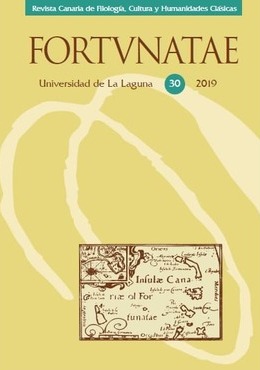Una ordalía atribuida al rey Salomón en un apócrifo árabe cristiano
Resumen
La versión árabe del Testamento de Salomón incluye un texto sobre una ordalía de reminiscencias bíblicas en la que el monarca debe finalmente impartir justicia ante la acusación de fornicio contra una joven. Se trata de un texto interesante en la tradición árabe cristiana, no tanto por la rareza del mismo, sino sobre todo por la dimensión y características narrativas del relato, cuya fuente es Nm 5,11-31, con referencias a Lc 10,38-42, o en su defecto a Jn 12,2
Citas
ABRAMSKY, Samuel - S. David SPERLING (2007): en Fred. SKOLNIK (ed.), Encyclopeadia Judaica (2ª ed.), 22 vols., Thomson-Gale, Detroit, pp. 755-759.
AEŠCOLY, A.Z. (1932): “Les noms magiques dans les apocryphes chrétiens des éthiopiens”, Journal Asiatique 220: 87-137.
BAGATTI, Bellarmino (1972): “I Giudeo-Cristiani e l’Anello di Salomone”, Rivista di Scienze Religiose 60: 151-160.
BEESTON, A.F.L., M.A. GHUL, W.W. MÜLLER, J. RYCKMANS (1982): Sabaic Dictionary − Dictionnaire sabéen − al-Mu‘jam al-saba’, Publication of the University of Sanaa, Éditions Peeters - Librairie du Liban, Lovaina La Nueva − Beirut.
BETZ, Hans Dieter (1986): The Greek magical papyri in translation. Including the Demotic spells. Volume one: Texts, The University of Chicago Press, Chicago - Londres.
CLINES, David J. A. (1993-2011): The Dictionary of Classical Hebrew, 8 vols., Sheffield Phoenix Press, Sheffield.
DE STRYCKER, E. (1961): La forme la plus ancienne du Protévangile Jacques. Recherches sur le Papyrus Bodmer 5 avec une édition critique et une traduction annotée, Subsidia hagiographica 33, Société des Bollandistes, Bruselas.
DE VAUX, Roland (1964): Les sacrifices de l’Ancien Testament, Cahiers de revue Biblique 1, Gabalda, París.
DE VAUX, Roland (1985): Instituciones del Antiguo Testamento, versión castellana de Alejandro ROS, Sagrada Escritura 63, Herder, Barcelona.
DELATTE, A. (1927): “Testament de Salomon”, Anecdota Atheniensia 36: 211-227.
DULING, Dennis C. (1983-85): “Testament of Solomon”, en James H. CHARLESWORTH (ed.), The Old Testament Pseudepigrapha, 2 vols., Darton Longman & Todd, Londres, vol. I, pp. 935-987.
DULING, Dennis C. (1988): “The Testament of Solomon: Retrospect and Prospect”, Journal for the Study of the Pseudepigrapha 2: 87-112.
FICHTNER, J. (1939): “Der AT-Text der Sapientia Salomonis”, Zeitschrift für die Alttestamentliche Wissenschaft 57: 155-192.
FRAENKEL, Siegmund (1886): Die aramäischen Fremdwörter im Arabischen, E. J. Brill, Leiden.
GREENGUS, Samuel (2011): Laws in the Bible and in Early Rabbinic Collections: The Legal Legacy of the Ancient Near East, Cascade Books, Eugene, Oregón.
GRÖZINGER, K. E. (1987): “The Names of God and the Celestial Powers: Their Function and Meaning in the Hekhalot Literature”, Jerusalem Studies in Jewish Thought 6: 53-69.
HOROVITZ, Joseph (1925): “Jewish Proper Names and Its Derivatives in the Koran”, Hebrew Union College Annual 2: 145-227.
KLUTZ, Todd E. (2005): Rewriting the Testament of Solomon. Tradition, Conflict and Identity in a Late Antique Pseudepigraphon, T&T Clark International, Londres.
LABIB, P. (1956): Coptic Gnostic Papyri in the Coptic Museum at Old Cairo, Government Press, El Cairo.
MCCOWN, Chester Charlton (1922): The Testament of Solomon, Edited from manuscripts at Mount Athos, Bologna, Holkham Hall, Jerusalem, London. Milan, Paris and Vienna, J. C. Hinrichs’sche Buchhandlung, Leipzig.
MINGANA, Alfonse (1927): “Syriac Influence on the Style of the Kur’an”, Bulletin of the John Rylands Library 11/1: 77-98.
MONFERRER SALA, Juan Pedro (2006): Testamentum Salomonis Arabicum. Edición, traducción y estudio, Studia Semitica 5, Servicio de Publicaciones de la Universidad de Córdoba, Córdoba.
MONFERRER SALA, Juan Pedro (2011): “A Fragmentary Version of the Protevangelium Iacobi Rendered from a Greek Text (Sinai Arabic 535, ca. 13th c.)”, Graeco-Arabica 11: 347-380.
GONZÁLEZ NÚÑEZ, Jacinto (1997): El Protoevangelio de Santiago, Editorial Ciudad Nueva - Fundación San Justino, Madrid.
NAVEH, Joseph, Shaul SHAKED (1985): Amulets and Magic bowls: Aramaic Incantations of Late Antiquity, The Magnes Press, Jerusalén.
PARKER, K. I. (1922): “Solomon as Philosopher King? The Nexus of Law and Wisdom in 1 Kings 1-11”, Journal for the Study of the Old Testament 53: 75-91.
PEREA YÉBENES, Sabino (2000): “Un antiguo ritual mágico semítico: la ordalía del «agua amarga de la maldición»”, en S. PEREA YÉBENES, El sello de Dios (Σφραγίς Θεοῦ). Nueve estudios sobre magia y creencias populares greco-romanas, Graeco-Romanae Religionis Electa Collectio 1, Signifer Libros, Madrid, pp. 145-153.
PORTER, B. (1967): “The Structure and Theme of the Solomon Narrative (1 Kings 3-11)”, Hebrew Union College Annual 28: 93-128.
RUIZ MORELL, Olga I. (1999): Las aguas amargas de la mujer. La ordalía de los celos en el rabinismo, Verbo Divino, Estella.
RYCKMANS, G. (19151): Les religions arabes préislamiques, Bibliothèque du Muséon 26, Publications universitaires, Lovaina.
SMITH, Dennis E., Michael E. WILLIAMS (1999): New Testament Women, The Storyteller’s Companion to the Bible 13, Abingdon Press, Nashville.
VON TISCHENDORF, Konstantin (1853): Evangelia Apocrypha. Adhibitis plurimis codicibus graecis et latinis maximam partem nunc primum consultis atque ineditorum copia insignibus, Avenarius et Mendelssohn, Leipzig.
TORIJANO, Pablo A. (2002): Solomon the Esoteric King: from King to Magus, Development of a tradition, Supplements to the Journal for the Study of Judaism 73, Brill, Leiden - Boston - Köln.
WASSEN, Cecilia (2005): Women in the Damascus Document, Academia Biblica 21, Society of Biblical Literature, Atlanta.
Los autores conservan los derechos de autor y garantizan a la revista el derecho de ser la primera publicación del trabajo al igual que licenciarlo bajo una Creative Commons Attribution License que permite a otros compartir el trabajo con un reconocimiento de la autoría del trabajo y la publicación inicial en esta revista.
Los autores pueden establecer por separado acuerdos adicionales para la distribución no exclusiva de la versión de la obra publicada en la revista (por ejemplo, situarlo en un repositorio institucional o publicarlo en un libro), con un reconocimiento de su publicación inicial en esta revista.





